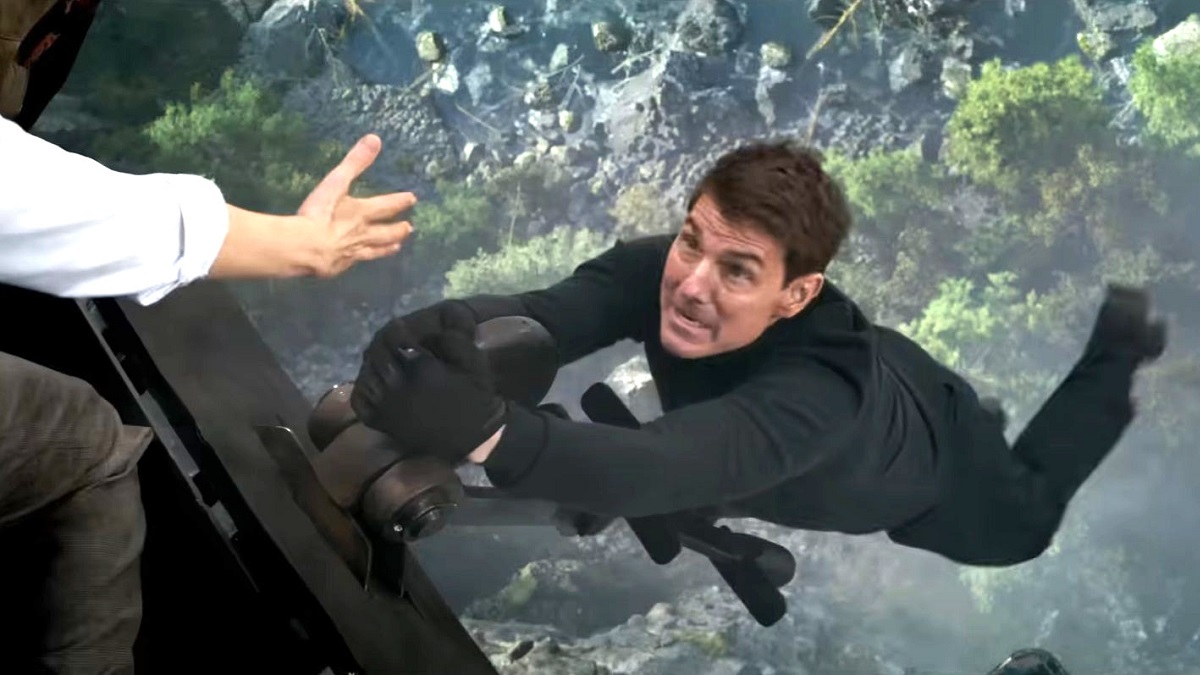Tom Cruise and Ethan Hunt are sort of the same guy. They both move heaven and earth to accomplish impossible feats, they both solve problems on the fly with easy smiles, and they both have perfect running form.
The Mission: Impossible series began in 1996 and is more successful than ever nearly 30 years later. Much of this can be attributed to the built-in fun factor of spy romps. Of course there’s also the draw of Cruise eschewing CG spectacle and doing his own insane stunts. But the consistent quality of the franchise — with a whole lot of peaks and very few valleys — has to be attributed to Cruise as a filmmaker; a dedicated producer and leading man whose superpower seems to be attracting the right talent at the right time to tell the right story.
In honor of Mission: Impossible – Dead Reckoning Part 1 hitting theaters this week, here is our ranking of the M:I entries, from worst to best.
7. Mission: Impossible 2 (2000)

M:I – 2 is a bit of a black sheep in the series, but it fits well into the franchise playbook of dramatic reinvention with each go-round. This entry was helmed by John Woo, the Hong Kong action maestro coming off an English-language hit with 1997’s Face/Off. If audiences went into this film expecting the balletic gunplay and overcooked melodrama of that Nicolas Cage and John Travolta-starring classic, they may have had a better time. But they presumably expected something along the lines of the first film, despite the M:I – 2 trailers showing Cruise’s long hair dramatically whipping around as he spins a motorbike to a nü-metal soundtrack. After a somewhat challenging first chapter, the mission statement here was one of pure late-‘90s escapism.
Unfortunately, the first sequel finds Ethan going toe to toe with an egregiously boring villain (Dougray Scott) in a tepid retread of Alfred Hitchcock’s Notorious. It could have overcome those issues if it hadn’t jettisoned the team element, which is a hallmark of the M:I franchise and separates it from the Bond and Bourne adventures of the same ilk. Ethan technically runs a small group that includes Ving Rhames’ Luthor and John Polson’s Billy Baird, but they cede most of their screen time to Cruise himself. Likewise, Thandie Newton as Hunt’s love interest fails to leave an impression beyond the state of misery she’s almost constantly experiencing.
There’s also an over-reliance on guns that feels a bit strange in a franchise that’s ostensibly about outplotting the enemy. We appreciate Woo’s style, but his fetishism of slow-motion revelations and over-calculated action makes the sequel feel more cumbersome than necessary.
6. Mission: Impossible 3 (2006)
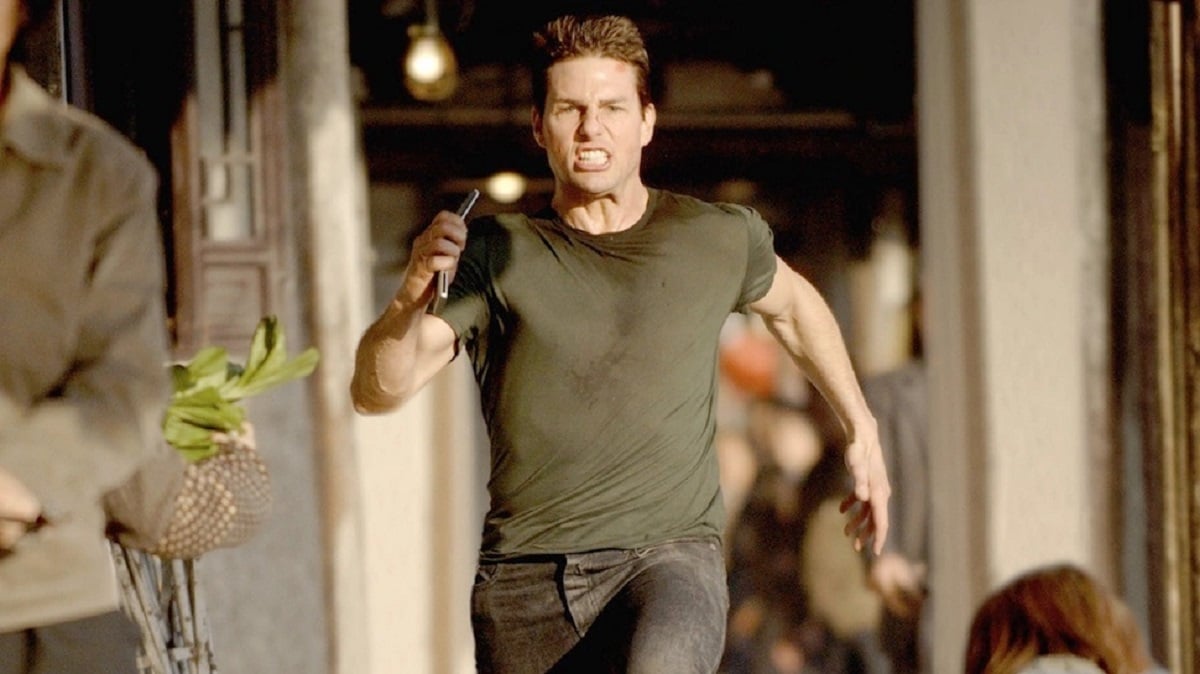
Even the staunchest J.J. Abrams defenders would admit that his inaugural film, M:I – 3, plays like a two-hour episode of his former ABC spy series Alias. But chasing the borderline lethargic stylings of Woo, Abrams’ brisk globetrotter can’t help but feel like a shot of adrenaline that the franchise desperately needed. It also packs an emotional wallop in ways the first two chapters don’t, as Ethan marries Julia, a civilian nurse played by Michelle Monahan, who of course finds herself in jeopardy because of what her husband does for a living. This is revealed in a shocking cold open where Cruise gives maybe his most emotional performance in the franchise while legendary baddie Owen Davian (a dialed-in Philip Seymour Hoffman) counts to 10 before seemingly pulling the trigger on Julia — before we even get a title card.
The movie is an absolute machine on the pacing front, taking a mere 10 or 15 minutes early on to retcon Ethan as more of a regular guy instead of the superman he seemed to be in Woo’s entry. Then Hunt is yanked through a host of action scenes that would probably benefit from Abrams pulling his camera back, but are no less intense under the claustrophobic framing. A heist at the Vatican and a later bridge assault are standouts, as is pretty much any scene with Hoffman, who is still the best villain this series has seen.
What’s terrific about Hoffman’s performance is how business-as-usual Davian’s cruelty is. He’s not giving speeches because he deeply cares about the cause; he speaks in short, clipped threats because he doesn’t have time for Ethan’s nonsense, and seems generally fatigued that there are heroes left in a world now driven by opportunists instead of ideologies. The film is definitely lacking in great stunt work, aside from Cruise jumping off a Shanghai skyscraper in a pretty brief sequence. But although it lacks the extended, pristine setpieces the series is known for, M:I – 3 is a scrappy upstart nonetheless.
5. Mission: Impossible – Rogue Nation (2015)
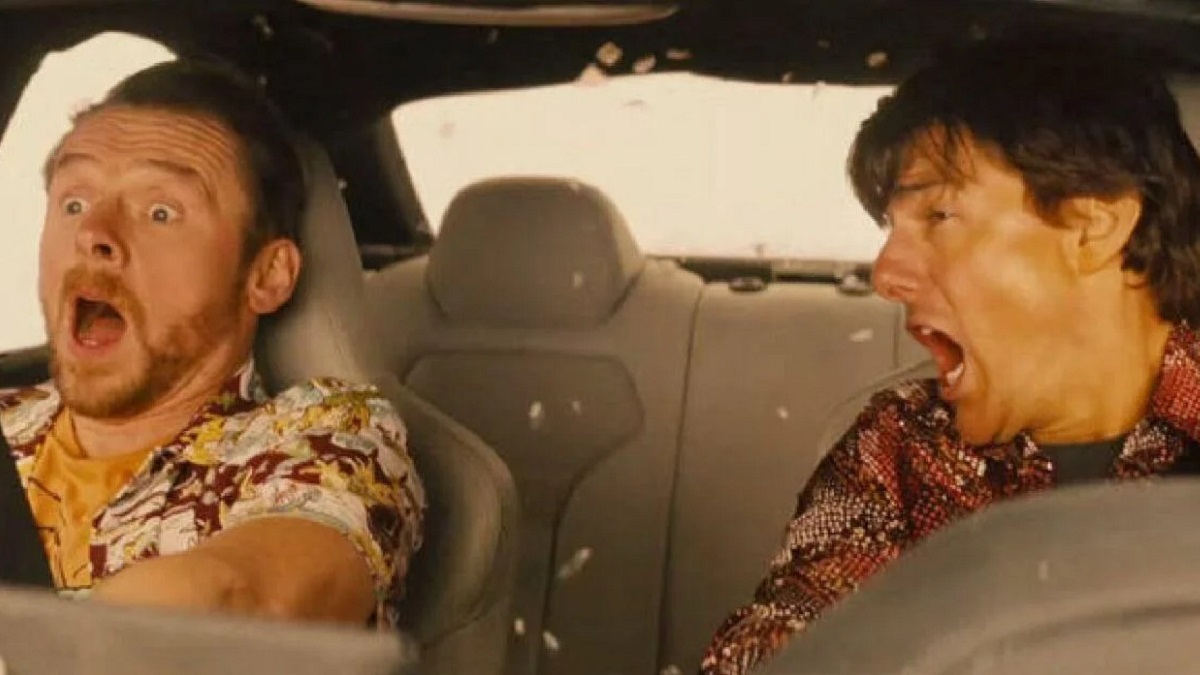
The fifth Mission — and the first directed by writer Christopher McQuarrie — is the only one to feel like a greatest hits album instead of its own distinct vision. But this isn’t true of the entire runtime. McQuarrie’s first and third acts align perfectly: Inspired by Carol Reed’s The Third Man, the writer/director casts Ethan as a man on the run from the IMF whose life becomes an unending negotiation of cobblestone streets and dark alleys. A standout setpiece is Hunt and Benji (Simon Pegg) trying to locate a nemesis at the Vienna State Opera. Here, McQuarrie excels at creating a new tone for the franchise with seductive shadow play, silhouettes, and more layers of double cross than Hunt has seen since the original movie.
But the director’s old-school style is upended by an admittedly entertaining second act in Casablanca, where Hunt has help from new series mainstay Ilsa Faust (an unforgettable Rebecca Ferguson) with infiltrating an underwater database. This leads to a car chase through outdoor markets and then a bike run at ridiculous speeds along curved mountain roads. It’s all handled with aplomb, but the sunbaked slapstick of cars flipping end over end and bikers clipping into guard rails feels directly inspired by Brad Bird’s larger-than-life antics in the fourth entry, Ghost Protocol. As a result, the middle section of Rogue Nation doesn’t quite match the more dire, mature sequences on either side of it.
Some people complain the final act strains under too much plot, but we think it delivers on what the early movements of Rogue Nation promise. McQuarrie’s first entry in the series is sure-handed and properly ambitious. We just wish it would have stuck to its nighttime subterfuge vibes the entire time.
4. Mission: Impossible – Ghost Protocol (2011)
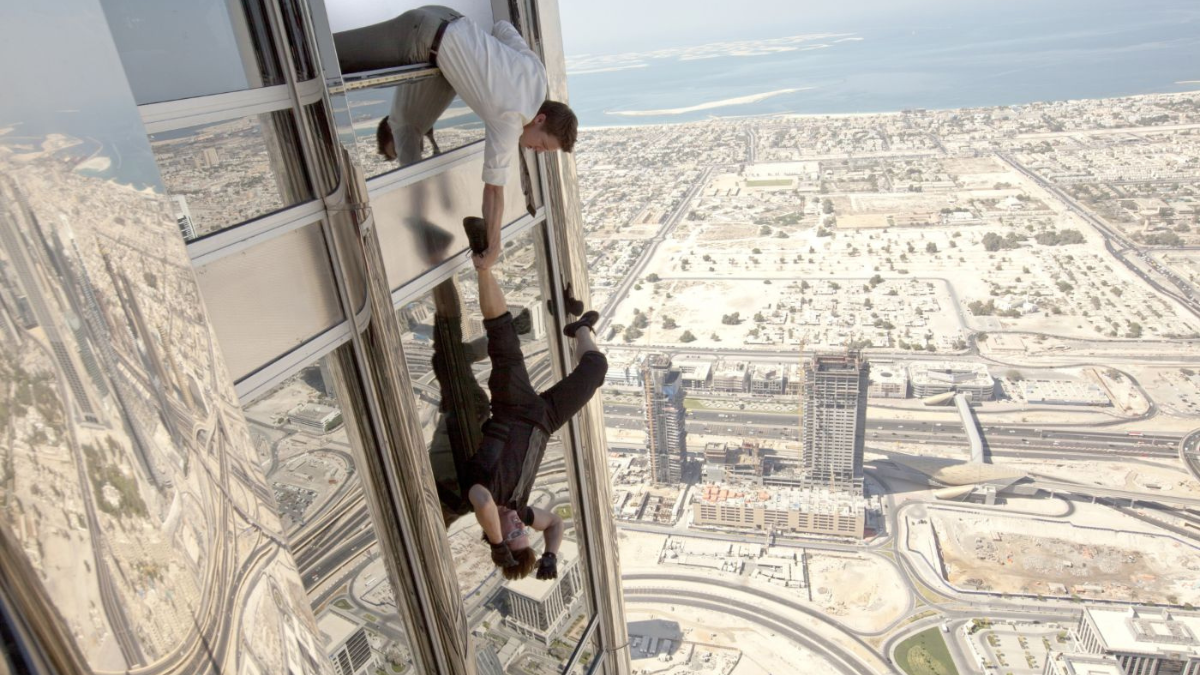
The fourth Mission was the first to be written by McQuarrie, though he remains uncredited for on-set rewrites and polishes. It’s also the first to really nail the formula, according to Cruise himself. We respectfully disagree, as you’ll find out higher on the list, but Ghost Protocol is still a certified stunner that boasts some of the best, most elaborately choreographed action of the series courtesy of director Brad Bird (who helmed The Incredibles and Ratatouille before switching to live-action here).
Bird’s background in animation and understanding of spatial relationships during action ensures the sequences are as crystal clear in their presentation as they are creative in their execution. No other action film can claim as inventive a setpiece as Hunt and Benji using a large projector screen to manufacture a fake hallway in the Kremlin. And never is geography in question when Cruise chases a villain up, down, and around an automated parking carousel during the climax.
The standout section here is the middle act in Dubai, where Cruise scales the Burj Khalifa, the tallest building in the world, which of course was captured for real in-camera. Then the film offers a clever double heist inside the building, which culminates in a car chase through a desert sandstorm that’s punctuated with a seriously cool car flip and unexpected mask reveal. We’ll admit this 25-minute sequence is probably the high point of the entire franchise.
However, what holds this entry back overall are the villains — or lack thereof. Although the film supplies at least two consistent bad guys, they’re rarely onscreen or given meaningful dialogue, which dilutes their threat considerably. Ultimately, these foes take a backseat to Bird’s jungle-gym topography and constantly failing tech as the more ever-present threats to our heroes. Personally, we prefer a more hands-on antagonist and fewer Road Runner hijinks in our M:Is. But we can’t argue with the results here.
3. Mission: Impossible – Dead Reckoning Part 1 (2023)

Dead Reckoning Part 1, the seventh film in the franchise, is the only one that feels like a spiritual sequel to the original 1996 M:I. This entry sees the return of Eugene Kittridge (Henry Czerny), a higher-up in the U.S. government who has a contestable relationship with Hunt. Fallout’s White Widow (Vanessa Kirby) continues her role as a courier in the criminal underworld — and the daughter of Vanessa Redgrave’s Max in the original film. There’s also the reprise of Hunt directly competing with his own government for information, breaking into a secure U.S. government facility, and even fighting a villain atop a speeding train. But instead of seeming like the franchise is out of ideas, Dead Reckoning Part 1 wears these early influences on its sleeve: Returning director McQuarrie is telling a story about patterns here; the inevitability of events based on characters’ repeat actions. It’s both a commentary on the Mission movies’ seemingly intractable structure and a liability exploited by an enemy that uses datasets to manipulate the protagonists.
Unfortunately, the hefty theme and ambitious story require several chunky exposition dumps that make the entire endeavor feel less polished than the best movies in the series. The extended cold open boasts at least two long speeches to set everything up before we get to the titles, and the preposterously grave circumstances invite dialogue that’s significantly hammier than what McQuarrie usually offers. He does what he can stylistically to aid his baroque musings on “the end of truth,” going full-tilt into Brian DePalma territory with an ever-roving camera and more Dutch angles than you’re likely to see in one film ever again. The effect is positively monolithic, as if the POV is craning upward at the lofty archetypes onscreen and the grand ideals they trade in.
On the excitement front, the movie’s got it where it counts. The action is more seamless than ever, with highlights including a cat-and-mouse foot chase through an airport, a demolition derby through the streets of Rome, and the much-vaunted stunt where Cruise drives a motorcycle off a cliff. There’s also some interesting hand-to-hand and hand-to-sword stuff here, including one very claustrophobic fight in what appears to be the narrowest alleyway in all of Europe. The cast is on point as well, with Haley Atwell bringing some welcome Selina Kyle energy and Pom Klementieff serving Harley Quinn vibes as a grandiose assassin. Esai Morales proves to be a somewhat dull henchman, unfortunately, but his physicality during the action is properly imposing, at least.
Perhaps Dead Reckoning Part 1’s continuous table-setting will go down smoother once next year’s sequel concludes the story. Consider the series-best title: an old maritime term for describing the navigation of a vehicle using its initial position, its velocity vector, and how long that velocity is maintained. In a sense, it was our first predictive algorithm. And the only way to beat a villain that can see every outcome is to do something with Dead Reckoning Part 2 that is truly surprising.
2. Mission: Impossible (1996)
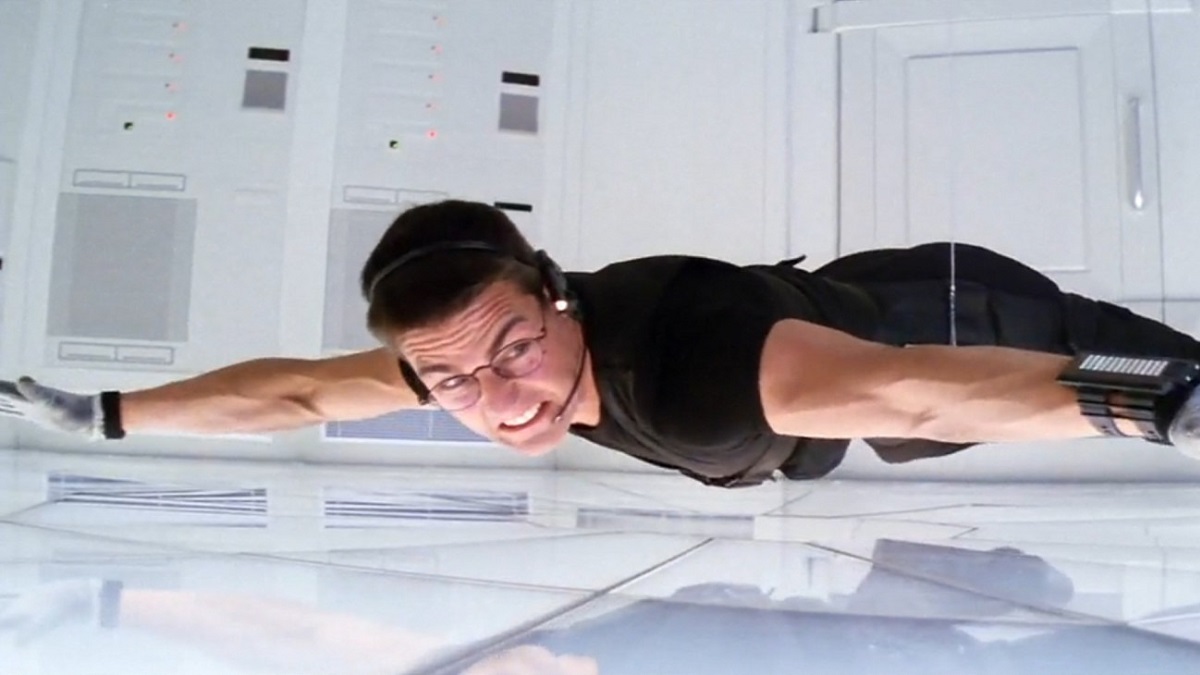
Brian DePalma’s Mission: Impossible didn’t exactly light the world on fire when it released. It was greeted with marginally good critical notes and a solid enough box office to warrant a sequel, but kids weren’t running around in Mission T-shirts or asking their parents to buy the VHS for Christmas. That might have had something to do with viewers not being able to follow the plot. Film critics Gene Siskel and Roger Ebert infamously confessed to not really understanding the movie (they still gave it two thumbs up), and our own comprehension of the storyline back in 1996 was murky at best. Then again, we were 11. But time has been kind to this first entry, possibly because its visuals are so enticing that we’ve gone back enough to watch DePalma do his thing that the narrative has become second nature by now.
The film is most famous for an all-timer heist where Hunt and friends must break into CIA headquarters and steal a disc from a secure room where you can’t touch the floor, make any noise, or alter the temperature with body heat. Film professors should teach this sequence as a blueprint for sustaining tension over a long period of time, as well as a tutorial for placing cameras in the best locations for maximizing anxiety.
Yet, the high point of Mission 1 might be the climax where Hunt fights the surprise villain atop a high-speed train traveling under the English Channel. This is one of the few simulated stunts in the series; we mention that because it somehow looks 100% convincing all these years later, seamlessly blending practical props and lighting with green screen and early CG. Just put this movie on mute at a gathering and watch people lose their minds thinking that Paramount let Tom Cruise actually do that.
Despite the gorgeous visuals, some Mission fans think all the secrets and double-crosses in this entry make the characters difficult to connect with. We sympathize, but we also think conspicuous figures wreathed in fog and reports of the unseen machinations against them match DePalma’s Cold War milieu quite well. It’s probably the most adult Mission, but it’s hard to enter this fantastical world with anything other than childlike wonderment.
1. Mission: Impossible — Fallout (2018)
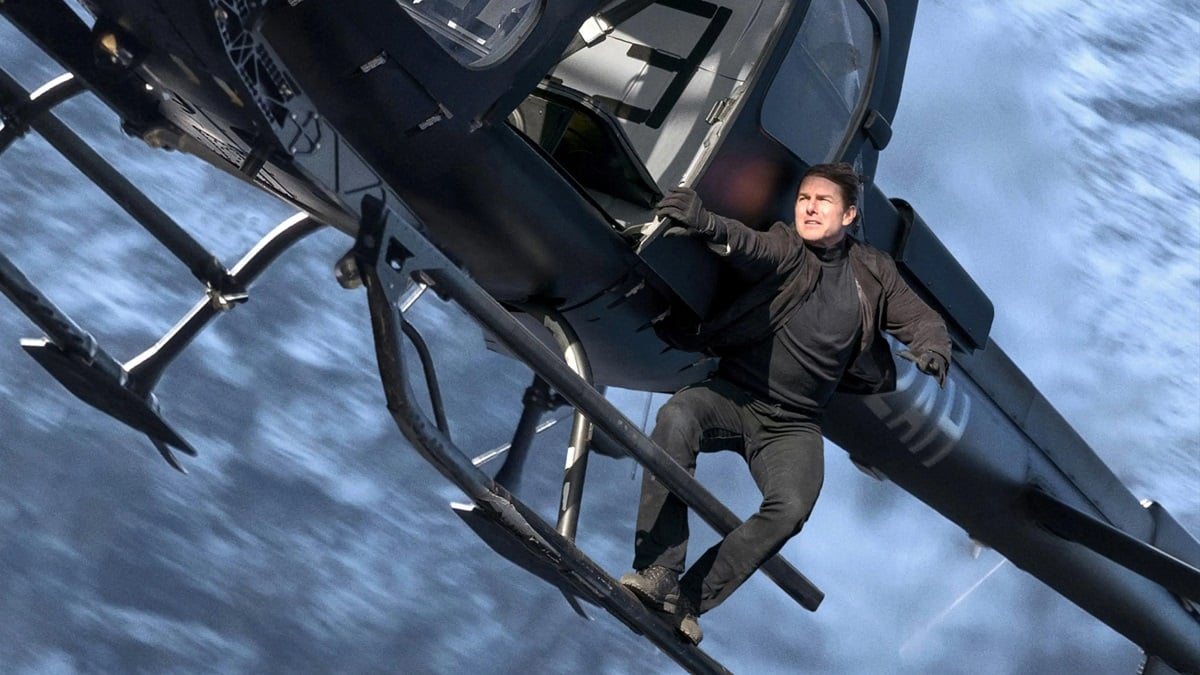
The sixth Mission is an absolute colossus of action filmmaking. Writer/director McQuarrie returns after the success of Rogue Nation, and despite being the franchise’s first repeat director, he maintains the series’ M.O. of bringing a new style to each entry. Where McQuarrie’s previous film alternated between shadowy palace intrigue and over-the-top chaos, Fallout is all about speed and heights, captured with the kind of steady push-ins and epic framing that would make Christopher Nolan blush.
The film has barely finished its opening credits before Cruise is doing a real HALO jump from the back of an airplane (along with an IMAX cameraman). Once Hunt has landed in Paris, he and his CIA competition — portrayed by a gloriously brusque Henry Cavill — engage in a brutal three-way fight with martial artist Liang Yang that destroys an entire bathroom. It gives a similar fight in James Cameron’s True Lies a run for its money, and is hands-down the best up-close fight in the Mission series. And that’s what Fallout is, essentially: a best-in-show of everything the franchise has ever attempted.
The middle act offers our favorite heist sequence, which involves springing Rogue Nation’s creepy villain (Sean Harris) from custody using freight trucks, motorbikes, and a speed boat. Cruse riding a motorcycle against traffic in the Arc de Triomphe circle is a particularly hair-raising stunt. Later, there’s a clever mask switcheroo, followed by the best sequence of Cruise running in a movie ever, which he did on a broken ankle for some shots. Somehow, the finale tops it all; cross-cutting between returning confidants Ilsa and Benji fighting for their lives against one villain while Cruise chases another by dangling from, then commandeering an enemy helicopter. The sequence was achieved, predictably, by Cruise learning to pilot a real helicopter while operating IMAX cameras attached to the aircraft.
By the end of Fallout, action fans are absolutely giddy with satisfaction. We walked out of it the first time saying the ticket should have been three times as expensive. Considering current pricing, that’s one hell of a claim.
As we eagerly anticipate next summer’s Mission: Impossible – Dead Reckoning Part 2, we’re reminded of the late Gene Siskel’s words when the first Mission premiered in theaters back in 1996, which pinpoint exactly why this franchise has been so creatively and commercially successful:
“My biggest compliments go to Cruise himself. He believes in his stories to such a degree that his conviction in the material bounces off the screen — and it carries us along, too.”

